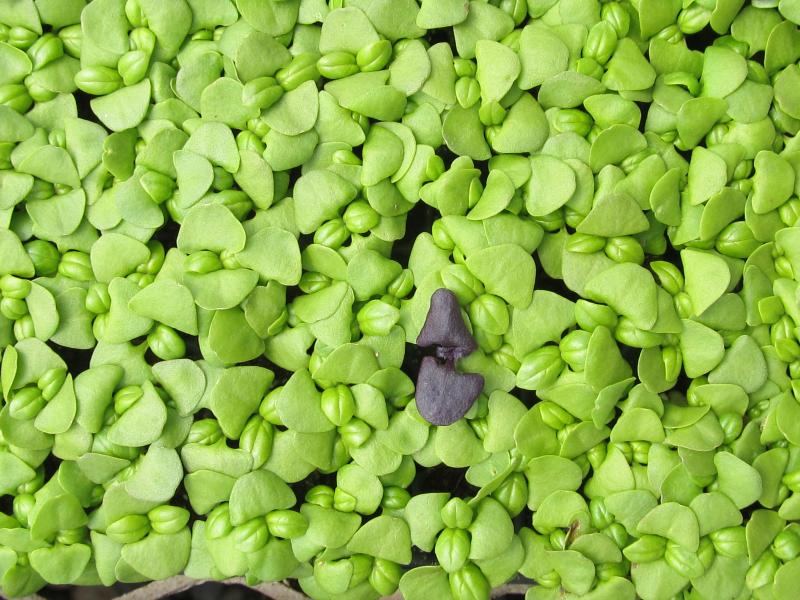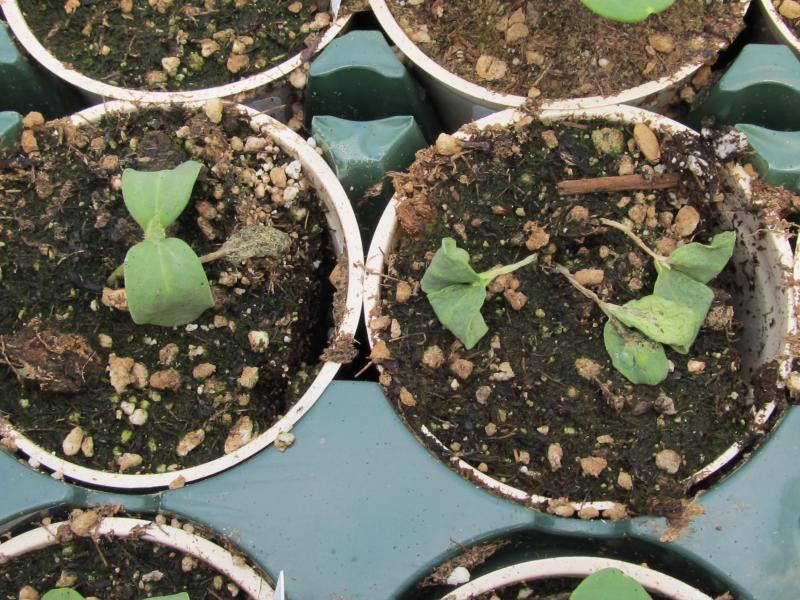Herbs: Your Worst Enemies

Herbs represent one of the fastest growing groups of plants over the last 15 years or so. Many are produced from seed directly or via plugs while others are produced from herbaceous cuttings. They are often finished by the same growers who produce bedding plants, ground covers and perennials, and some are used for purely ornamental purposes such as lavender and rosemary. Since many herbs are produced by seed, the diseases that often attack them can be the same as those attacking seed grown ornamentals.
Many of our most common herbs fall into either the Apiaceae or the Lamiaceae family and the pathogens that attack them are often able to attack many members of that plant family. Apiaceae includes dill, cilantro and parsley. Lamiaceae is an even larger group of herbs and includes basil, catnip, lavender, marjoram, mint, oregano, rosemary, sage and thyme. Some of the Lamiaceae are Mediterranean in origin and therefore do not do well in a high water, high fertility environment common to greenhouse/nursery production.
The problems may seem worse in some respects since the genetics of our herbs are pretty closely related, and many are attacked by some of the same pathogens. While some of the pathogens are specific to a given herb, others are very broad-spectrum. Examples of broad-spectrum pathogens include Botrytis cinerea (Botrytis blight), Sclerotinia sclerotiorum (white mold), some powdery mildews, Rhizoctonia solani (aerial blight and crown rot), some bacterial leaf spots and blights (Pseudomonas) and Pythium root rot. Pathogens that are more specific include : Fusarium oxysporum, downy mildews, rusts and Xanthomonas campestris leaf spots and blight.
Seed-borne Diseases
Seed-borne pathogens include fungi like Alternaria, Cercospora and Colletotrichum, and bacteria including Pseudomonas and Xanthomonas. Xanthomonas leaf spots are more common in the summer due to the increased overhead irrigation or rainfall and the increased temperatures. Pseudomonas spp. can also increase in the summer and may be found on basil, cilantro, oregano and parsley. All of these leaf spots can be a problem in the landscape as the plants fill in and leaves stay wet overnight. Overhead irrigation and crowding can lead to an outbreak of leaf spots during production anytime. It is not uncommon to find more than one pathogen involved in an outbreak of leaf spot or blight.
Lavender plugs with a combination of Botrytis blight and Xanthomonas.
Damping Off
Why are herbs subject to damping-off diseases? The answer to this one could not be more obvious at least to me. If you start with a seed, it can be attacked immediately following sowing, which lead to damping-off. A wide variety of soil-borne pathogens including Fusarium, Phytophthora, Pythium and Rhizoctonia are recognized for attacking seeds. They can be prevented by appropriate fungicide use. One concern is the use of fungicides to prevent damping-off, which has been demonstrated to reduce percent or speed of seed germination on other annuals like bedding plants. This is minimized by producers who rely on cultural and biological prevention, which are also very effective.
Botrytis and Bacterial Blights
The biggest problem with herbs that are propagated from unrooted cuttings is that they might start with a bacterial infection or be attacked by Botrytis during propagation. Mist propagation conditions are ideal for foliar diseases caused by bacteria like Pseudomonas and Xanthomonas as well as Botrytis, which is highly favored by wounding and wet leaves. Use of pathogen-free unrooted cuttings as well, as avoiding over-watering, is the best way to minimize these diseases.
 Damping off on melon seeds.
Damping off on melon seeds.
Controlling Herb Diseases
Herbs don’t have any more diseases than most of the ornamentals we produce, and the fungicides that control powdery mildew on rose or hydrangea do control the same type of disease on herbs. The unfortunate fact that herbs can and are used for culinary purposes makes controlling diseases and pests on herbs a real challenge. Greenhouse (or container) grown herbs have very few legal fungicide or bactericide registration. While ornamentals are a very small target for many chemical companies, herbs don’t even make it on the radar.
The first step to control any disease is to know what the disease is and the second step is to know how it started. Some diseases start through use of contaminated seed, for example Fusarium wilt on basil. Others start as contaminated cuttings such as bacterial leaf spots on lavender and rosemary. On both cases, control must start at the very beginning of the crop cycle since the plants come with the problem. Preventative treatments with some fungicides or bactericides can help as well as minimizing the conditions that promote disease. In still other cases, the pathogen is introduced from other diseased crops (like Botrytis, Sclerotinia and powdery mildew) or is present on contaminated benches or pots (like soil-borne pathogens including Pythium, Phytophthora and Rhizoctonia).
Basil plugs with Pseudomonas blight.
Conclusions
Follow these steps to control herb diseases:
1. Know what the common diseases of your herb crops are and what they look like.
2. Remember that prevention is always more effective than eradication.
3. Keep records of what diseases occur and when they occur for future reference.
4. Read product labels and follow them carefully.
Disclaimer: The products mentioned in this article are not the only products labeled for herbs, and their listing is not meant as a recommendation or endorsement of their use. Be sure to read the labels of any product you use to make certain they are labeled for the use you intend. Some states, or even counties within the same state, have more restrictive interpretations than others. When in doubt contact your local county agent or farm advisor to make sure the use is legal.


 Video Library
Video Library 




















